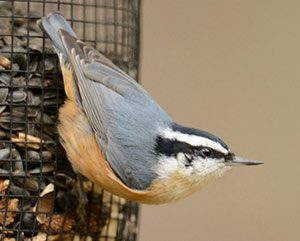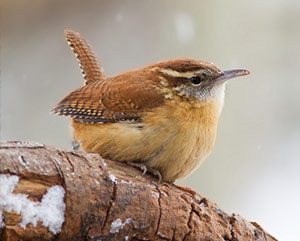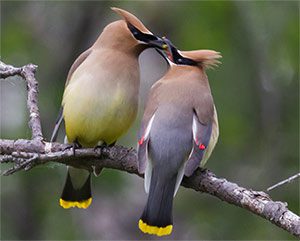Originally published March 2015; updated February 2025.
When birds visit your feeder, they’re doing a lot more than just feeding. They’re coming and going, watching for openings or threats, and interacting with each other in a well-established social pecking order.
At first it looks like just a flurry of activity—but watch closely and you’ll start to see a daily struggle of dominance playing out in your backyard.
Some types of dominant or submissive behavior are easy to pick out with a little practice, and this can give you a little inside information on your feeder birds. Watch for when one bird changes its posture in the presence of another, or how some birds preemptively give up their spot when another bird approaches. Here’s a quick primer on some of the most common moves.
Note: The videos in this post have been slowed down to one-half or one-quarter speed—things will happen a lot faster at your home feeders.
Displacement
One of the most common and easiest to see behaviors, displacement occurs anytime one bird leaves to get out of the way of another bird. Displacement also plays out when one bird waits nearby for another to finish eating before flying over to a feeder. Within the same species, generally speaking, males tend to dominate females and older birds dominate younger ones. Feeder hierarchies can also involve birds of several species, with the larger species usually winning out over the smaller.
Threat Displays
Sometimes a dominant bird doesn’t need to displace a subordinate to exert influence. Watch for specialized threat displays designed to convey aggressive intent, such as a chickadee’s bill-up display in which he tilts his bill straight up. You’ll also often see dominant White-breasted Nuthatches giving a characteristic threat display in which the bird partially fans its wings and sways side-to-side in the direction of its opponent. This can be a subordinate bird or sometimes a predator. (See the accompanying video, in which a male nuthatch performs a wing-spread display as he faces off against a red squirrel that’s too near his nest box.)
Appeasement
Dominant birds aren’t the only ones that signal their intent through behavior. Subordinate birds also have an incentive to communicate, to help de-escalate confrontations. These appeasement displays are often the opposite of threat displays. Subordinates may de-emphasize their size by showing a sleeker, smaller posture that seems to shy away from interaction. Watch for birds that deliberately lean or look away from a newly arrived bird, often while crouching or folding their wings in. When the dominant bird leaves, you may see the subordinate bird resume its normal posture.
Watch the posturing as these three Black-capped Chickadees work out their positions at the feeder. There’s some squabbling at the beginning, but notice how one chickadee ends up getting pushed to the windy, snowy side of the feeder and leans or edges away from further interactions. The two chickadees on the sheltered side seem to tolerate each other well and may be mates. (We also love the curious Northern Cardinal who seems to be observing the interactions almost as closely as a behavioral scientist would.)
Does Dominance Matter?
When a dominant nuthatch occupies a feeder and forces the others to wait until he’s done eating, it’s more than just birdy bullying—it can be life and death. Research has shown that dominant birds forage in safer spots and at safer hours of the day (when there’s less predation). Accordingly, they get eaten by predators less frequently, are able to maintain a better body condition throughout the lean winter months, and have higher survivorship.
This last video helps illustrate another fact of biology: rules are rarely cast in stone, and birds often surprise you. Here, a Tufted Titmouse pushes a Black-capped Chickadee away from the favored side of the feeder—until a new arrival sends both birds packing.
Solo or Social? Patterns in Bird Behavior
You may have noticed that some birds at your feeder are more pugnacious than others. Some species seem to have different temperaments and regularly behave in either aggressive or submissive manners. Here are three examples:
 Feisty and Ready to Fight. Red-breasted Nuthatches are notoriously aggressive. While they’re about the same size as chickadees, Red-breasted Nuthatches will completely dominate chickadees whenever they get the chance.
Feisty and Ready to Fight. Red-breasted Nuthatches are notoriously aggressive. While they’re about the same size as chickadees, Red-breasted Nuthatches will completely dominate chickadees whenever they get the chance. Socially Unaware. Carolina Wrens appear to be utterly oblivious to other birds while camping out at a peanut feeder. They don’t move until they’re good and ready… unless a Blue Jay comes along.
Socially Unaware. Carolina Wrens appear to be utterly oblivious to other birds while camping out at a peanut feeder. They don’t move until they’re good and ready… unless a Blue Jay comes along. Happy Campers. If you’re looking for some good examples of avian dominance, don’t watch Cedar Waxwings. Somehow they seem able to stay above the fray, even when flocks of 30-plus waxwings are feasting on fruit at a crabapple or mountain-ash tree.
Happy Campers. If you’re looking for some good examples of avian dominance, don’t watch Cedar Waxwings. Somehow they seem able to stay above the fray, even when flocks of 30-plus waxwings are feasting on fruit at a crabapple or mountain-ash tree.
The Science of Bird Dominance
In 2018, scientists did a massive analysis of interactions that had been reported by Project FeederWatch participants. The data allowed them to determine a single, comprehensive hierarchy (or pecking order) for more than 130 species of birds in North America.
A follow-up study added in the effect of birds that visit feeders in groups, finding that having flockmates gave birds an advantage in the feeder free-for-all:
How to Bring birds into your backyard:
Images via Birdshare: Red-breasted Nuthatch by JanetandPhil, Carolina Wren by Mike P, Cedar Waxwings by Roger P. Kirchen.

